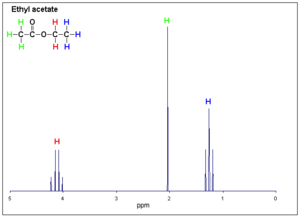Difference between revisions of "NMR spectrometer"
Cmditradmin (talk | contribs) m (→Background) |
Cmditradmin (talk | contribs) m (→Background) |
||
| Line 8: | Line 8: | ||
Nuclear magnetic resonance NMR spectroscopy is a sensitive chemical analytical technique which detects the magnetic properties of certain atoms such as hydrogen and carbon. The resulting spectrum can be compared against a database of known NMR signatures to identify atoms or functional groups in sample mixture. A typical application is to use NMR to prove that a sample pure or has completed a reaction. | Nuclear magnetic resonance NMR spectroscopy is a sensitive chemical analytical technique which detects the magnetic properties of certain atoms such as hydrogen and carbon. The resulting spectrum can be compared against a database of known NMR signatures to identify atoms or functional groups in sample mixture. A typical application is to use NMR to prove that a sample pure or has completed a reaction. | ||
<swf width="500" height="400"> | <swf width="500" height="400">images/b/be/Nmr.swf</swf> | ||
=== Significance === | === Significance === | ||
Revision as of 14:46, 29 September 2010
| Return to Research Tool Menu |
Background
Nuclear magnetic resonance NMR spectroscopy is a sensitive chemical analytical technique which detects the magnetic properties of certain atoms such as hydrogen and carbon. The resulting spectrum can be compared against a database of known NMR signatures to identify atoms or functional groups in sample mixture. A typical application is to use NMR to prove that a sample pure or has completed a reaction.
<swf width="500" height="400">images/b/be/Nmr.swf</swf>
Significance
Protons create different resonance spikes depending where they are located on the molecule. Non identical protons will exhibit individual peaks. But equivalent protons will couple to create a single stronger peak.
Operation
This provides instructions for a Bruker Advance 300 NMR.
Below is an excellent video from RSC

